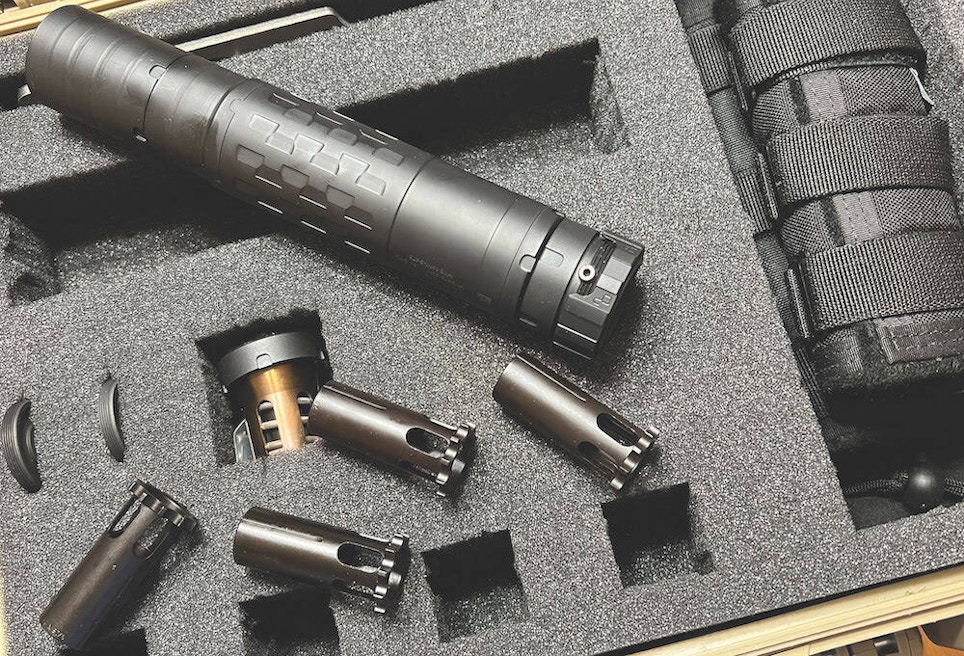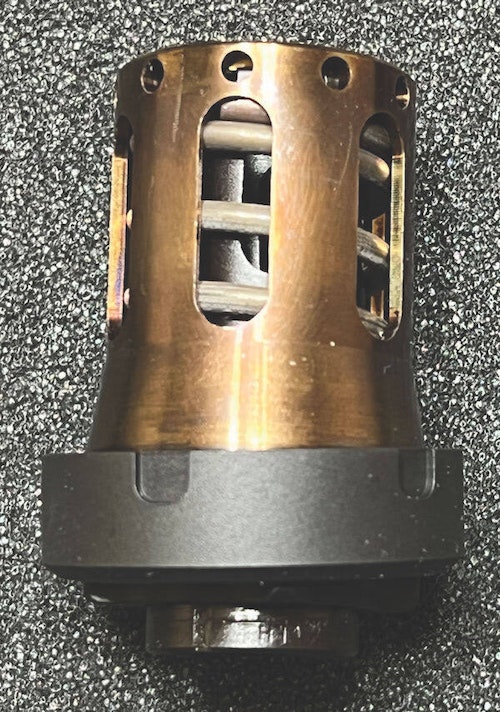You may have heard the terms “Booster” or “Nielsen Device” when talking about silencers, but you may not know what they mean. I’m sure you have a general idea that they make a semi-automatic pistol function when a silencer is attached. What you may not know is precisely how they work. That’s OK. Let’s trip back in time to understand what problems the inventors faced and the solutions they created. Let’s go back about 300 years to the early days of scientific inquiry.
Sir Isaac Newton was a scientist who lived from 1643 to 1727. You probably remember him as the guy whose consciousness was suddenly raised when an apple fell on his head. That tale is perhaps an exaggeration, but his notes say it was a falling apple that inspired his work on force and motion. It’s not essential to remember the dates of his life – or even his name. But It’s critical that you understand the basics of his Three Laws of Motion. Don’t worry; it isn’t complicated, and there won’t be a test afterward.
Newton’s Three Laws of Motion:
- Inertia - An Object at rest remains at rest, and an object in motion stays in motion at a constant speed and in a straight line unless acted on by an unbalanced force.
- Force - An object's acceleration depends on the object's mass and the amount of force applied.
- Action & Reaction - Whenever one object exerts a force on another object, the second object exerts an equal and opposite force on the first.
What does that have to do with guns? Let’s move forward in time to around 1884 and consult Hiram Maxim.
Hiram Maxim was an American-British inventor best known for creating the first successful machine gun in history. It was appropriately named the “Maxim Gun.” Chambered in 5x57mm Mauser or 303 British, the Maxim Gun was heavy, water-cooled, rested on a tripod or carriage, and was manned by a three- or four-man crew. It was capable of firing 550 to 600 rounds per minute. This was astounding back in 1884, and the Maxim gun became an instant hit with the armies of many nations.
Ten years after its invention, however, the U.S. Navy wanted to test the Maxim with their newly adopted 6mm U.S.N. cartridge (also known as the 6mm Lee Navy). This small-caliber cartridge operated on lower pressures to reduce barrel wear in rifles and machine guns. As a result, the cartridge produced much less recoil than the 5x57mm Mauser or the 303 British. That’s good unless you depend on the recoil to operate the action on a machine gun. The test failure sent the inventor to the drawing board with a new problem. Six months later, he filed a patent for an “apparatus to increase the recoil energy” for low-powered cartridges. He called it a recoil booster, and the name “Booster” is still used today.
Maxim’s solution was to mount a cup-like device to the end of the barrel that temporarily captured part of the expanding gasses from a fired cartridge. This resulted in less bleed-off and increased the pressure in the barrel. In Newtonian terms, the restriction of the gasses from traveling in one direction pushed back the gasses in the other direction and slowed them down. It’s a combination of the First and Third Laws of Motion. The captured gasses were the force acting on the object in motion (the gasses in motion). The result was that pressure in the barrel boosted the recoil, allowing the action to function as if a larger caliber was used.
The Nielsen Device
Although commonly called a booster, the Nielsen device was an expansion or adaptation of Maxim’s booster and was used to solve a different issue. Let’s look at how a semi-automatic pistol functions and the problem being confronted.
Most semi-automatic pistols are recoil-operated. The fired cartridge produces a large amount of expanding gas that pushes the bullet through and out of the barrel. The force of the gas doesn’t just act on the bullet. Newton’s Third Law of Motion states that for every action or force, there is an equal and opposite reaction. As the gas pushes the bullet through the barrel, it also pushes back in the opposite direction and forces the barrel and slide to the rear. Imagine a balloon full of air. When released, the pressure inside rapidly forces the air to escape. The escaping air is going in one direction, pushing the balloon in the opposite direction. The same forces are at work in the pistol. It moves the barrel and slide to the rear, unlocking the action, extracting the fired casing, and loading a new cartridge into the chamber. It’s the recoil doing the work.
Let’s suppose that we wish to protect our hearing by adding a silencer to the barrel of our pistol. This is where Newton’s First and Second Laws come into play. Adding more mass to the end of the barrel necessitates more energy to move it. If the added mass of the suppressor prevents the barrel’s movement, we’re left with a non-functioning gun. Our semi-auto just became a single-shot pistol.
A Neilson device is a component that connects the barrel of a semi-automatic weapon to a suppressor yet allows the added mass of the suppressor to separate from the mass of the barrel/slide assembly when the gun is fired. The device is made up of four main components:
The piston, the piston housing, a spring, and an endcap that holds it all together. The piston (#30 in the drawing) is meant to be screwed directly to the end of the pistol’s barrel using the threads (#31). The piston housing (item #20) is screwed into the silencer’s body. The spring, once held in place by the endcap, holds pressure on the piston and housing to hold them together and in alignment.
Think of it as a metal balloon. Like the Maxim Booster, the Nielsen Device is designed to temporarily delay the gasses from a fired cartridge and use their energy. When the cartridge is fired, the gasses fill the space between the piston and piston housing. The walls of this balloon can’t expand, so they push the housing and the piston in opposite directions. At that instant, the barrel and silencer are effectively separated for more than the 55-65 milliseconds needed for the pistol’s action to cycle without the added mass of the suppressor. The gasses eventually escape, and the spring’s tension pulls the piston and housing back together and into proper alignment. The Nielsen Device was an ingenious solution and is still in use today.
Now’s the time to thank Sir. Isaac Newton, Hiram Maxim, and HC Nielsen for bringing machine guns and silencers into practical use. We can now burn through ammo faster than our wallets can endure while ensuring we can still hear after the money is gone. Who knew that physics could be so fun?







